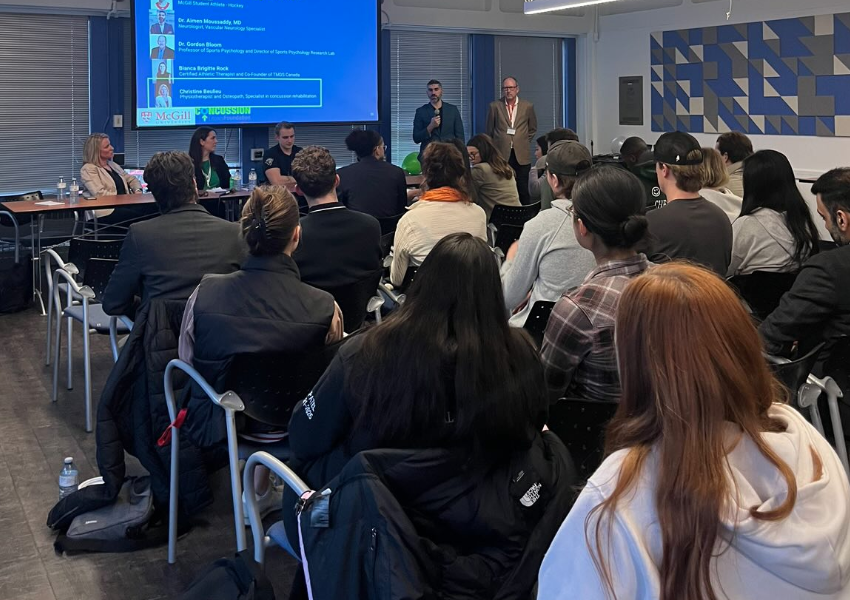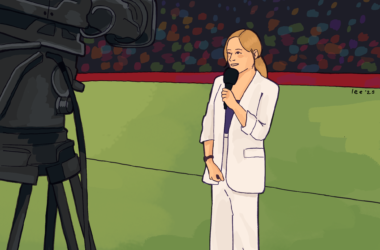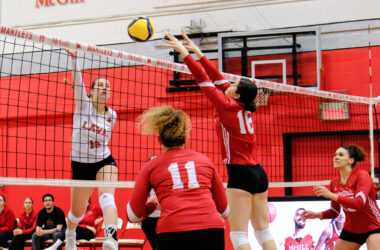On March 28, the McGill Students for Concussion Legacy Foundation (CLF McGill) hosted their annual symposium. Co-Presidents Trisha Tee, a second year master’s student in experimental surgery, and Lily MacDonald, a third year undergraduate Dietetics student, explained that with this year’s panel titled “Impact Zone: Navigating Sports-Related Concussions,” they hoped to illuminate the wide range of different approaches to concussion treatment throughout the sports world.
“The goal of this panel is really to get everyone together to have an interdisciplinary approach to concussion care, treatment, recovery, rehab, and really get a bunch of the different multidisciplinary views on how to treat it rather than just one way,” MacDonald told The Tribune.
The first speaker was Evan Patrician, a former hockey player for the McGill Redbirds who quit the team this year after sustaining five concussions in the span of four years. Patrician detailed his experience with concussions.
“After the most recent concussion before the summer of 2023, short-term memory [loss] was beginning to creep into my daily life frequently,” Patrician said.
Patrician explained that despite attending training camp at the start of the 2023-24 season, he was scared to get hit. This led him to take some time away from hockey and ultimately decide that continuing to play hockey could negatively affect his pursuit of academic and career goals. Patrician also touched on the stigma surrounding concussions in hockey.
“Junior hockey is your full-time job and your health is second,” Patrician explained.
Gordon Bloom, a professor in the Department of Kinesiology and Physical Education and the Director of the Sports Psychology Research Lab at McGill, spoke next. Bloom narrowed in on a discussion of the psychosocial aspects of post-concussion rehabilitation in athletes, highlighting the psychological aspects of recovering from a concussion. He explained concussions are difficult as they do not have a clear recovery timeline and as an “invisible injury,”, people often think athletes are faking it.
Bloom discussed the advances in understanding and treating concussions since the early 2000s, highlighting the role of Eric Lindros’s 2011 concussion in bringing public attention to the issue. He then discussed the importance of qualitative studies in understanding what it is like for athletes to live with concussions.
“For me, this was a real turning point, this article, because we finally had the empirical evidence that says, if you have multiple brain trauma injuries, and you don’t let it heal properly, your quality of life is going to be severely damaged,” Bloom said.
Dr. Aimen Moussaddy, a neurologist specializing in vascular neurology, followed Bloom with a discussion of how he treats post-concussion symptoms. He explained the difficulties of treating patients when wait times are often weeks, if not months. Moussaddy also explored two ways of seeing how damage manifests in the concussed brain.
“Axonal injury, which comes back to the fact that our brains are just a lump of wires […] those wires get twisted […] and that twist of wires ends up causing inflammation around the wires, and those wires to be dysfunctional,” Moussaddy said. “That dysfunction of wires can be reversible and temporary, or after repetitive effects, or depending on the severity of that one impact of that trauma may be irreversible [….] The second part of head trauma also modifies the way we release chemicals in our brain.”
Bianca Brigitte Rock, a certified athletic therapist and co-founder of TMDS Canada, discussed a biophysical approach to concussions and outlined the importance of an interdisciplinary approach to treating concussions. Rock explained that there are five different spheres of symptoms: Physical, cognitive, sleep, affective, and the autonomic nervous system––anything to do with physical activity.
Finally, Christine Beaulieu, a physiotherapist and osteopath specializing in concussion rehab spoke about the development of research on the physical activity after a concussion. She explained the process of developing consensus statements on concussion in sport which are produced at the International Conference on Concussion in Sport which occurs every four years.
“The consensus statement is kind of the reference that people look at to create all of the policies and protocols on concussion,” Beaulieu said. “In 2022 […] this is where we see the biggest changes in the approach to rehabilitation [….] In terms of physical activity, now we say it is safe to start physical activity within two to 14 days after the concussion.”
The panel concluded with a Q&A session in which the audience asked the panellists about professional sports leagues’ concussion protocols, the gaps in concussion research along the lines of age and gender, and the need for public figures and government officials to speak up about the dangers of concussions.









